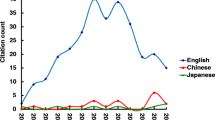Abstract
In clinical research on complementary and integrative medicine, experts and scientists have often pursued a research agenda in spite of an incomplete understanding of the needs of end users. Consequently, the majority of previous clinical trials have mainly assessed the efficacy of interventions. Scant data is available on their effectiveness. Comparative effectiveness research (CER) promises to support decision makers by generating evidence that compares the benefits and harms of the best care options. This evidence, more generalizable than the evidence generated by traditional randomized controlled trials (RCTs), is better suited to inform real-world care decisions. An emphasis on CER supports the development of the evidence base for clinical and policy decision-making. Whereas in most areas of complementary and integrative medicine data on comparative effectiveness is scarce, available acupuncture research already contributes to CER evidence. This paper will introduce CER and make suggestions for future research.
Similar content being viewed by others
References
Consortium of Academic Health Centers for Integrative Medicine. Definition developed and adopted by The Consortium. 9 June 2012. Available from: URL: http://www.imconsortium.org/about/home.html.
Dobos G. Integrative medicine—medicine of the future or “old wine in new skins”? Eur J Integr Med 2009;1:109–115.
Chen SK, Wei BH, Chen XY. The developing integrative medicine. Jinan: Shandong Science and Technology Publishing House; 2001.
Last J, Spasoff, RA, Harris S. A dictionary of epidemiology. 4 ed. Oxford: Oxford University Press; 2001.
Pcori. What we do? 17 June 2012. Available from: URL: http://www.pcoro.org/what-we-do/.
Fonnebo V, Grimsgaard S, Walach H, Ritenbaugh C, Norheim AJ, MacPherson H, et al. Researching complementary and alternative treatments—the gatekeepers are not at home. BMC Med Res Methodol 2007;7:7.
Institute of Medicine. What is comparative effectiveness research? initial national priorities for comparative effectiveness research. Washington D.C.: The National Academies Press; 2009:29.
Institute of Medicine, ed. Initial national priorities for comparative effectiveness research. Washington D.C.: The National Academies Press; 2009.
Metcalfe A, Williams J, McChesney J, Patten SB, Jette N. Use of complementary and alternative medicine by those with a chronic disease and the general population—results of a national population based survey. BMC Complement Altern Med 2010;10:58.
Keyhani S, Woodward M, Federman AD. Physician views on the use of comparative effectiveness research: a national survey. Ann Intern Med 2010;153:551–552.
Hoffman A, Montgomery R, Aubry W, Tunis SR. How best to engage patients, doctors, and other stakeholders in designing comparative effectiveness studies? Health Aff (Millwood) 2010;29:1834–1841.
Selby JV. The researcher-in-chief at the Patient-Centered Outcomes Research Institute. Interview by Susan Dentzer. Health Aff (Millwood) 2011;30:2252–2258.
Tunis SR, Benner J, McClellan M. Comparative effectiveness research: policy context, methods development and research infrastructure. Stat Med 2010;29:1963–1976.
Zwarenstein M, Treweek S, Gagnier JJ, Altman DG, Tunis S, Haynes B, et al. Improving the reporting of pragmatic trials: an extension of the CONSORT statement. BMJ 2008;337:a2390.
Thorpe KE, Zwarenstein M, Oxman AD, Treweek S, Furberg CD, Altman DG, et al. A pragmatic-explanatory continuum indicator summary (PRECIS): a tool to help trial designers. CMAJ 2009;180:E47–E57.
Tunis SR, Stryer DB, Clancy CM. Practical clinical trials: increasing the value of clinical research for decision making in clinical and health policy. JAMA 2003;290:1624–1632.
Vickers AJ, Rees RW, Zollman CE, McCarney R, Smith CM, Ellis N, et al. Acupuncture for chronic headache in primary care: large, pragmatic, randomised trial. BMJ 2004;328:744.
Thomas KJ, MacPherson H, Thorpe L, Brazier J, Fitter M, Campbell MJ, et al. Randomised controlled trial of a short course of traditional acupuncture compared with usual care for persistent non-specific low back pain. BMJ 2006;333:623–626.
Witt CM, Manheimer E, Hammerschlag R, Ludtke R, Lao L, Tunis SR, et al. How well do randomized trials inform decision making: systematic review using comparative effectiveness research measures on acupuncture for back pain. PLoS ONE 2012;7:e32399.
Flower A, Witt C, Liu JP, Ulrich-Merzenich G, Yu H, Lewith G. Guidelines for randomised controlled trials investigating Chinese herbal medicine. J Ethnopharmacol 2012;140:550–554.
Witt CM. Clinical research on acupuncture-concepts and guidance on efficacy and effectiveness research. Chin J Integr Med 2011;17:166–172.
Campbell M, Fitzpatrick R, Haines A, Kinmonth AL, Sandercock P, Spiegelhalter D, et al. Framework for design and evaluation of complex interventions to improve health. BMJ 2000;321:694–696.
Center for Medical Technology Policy. Effectiveness guidance documents (2012). 11 June 2012. Available from: URL: http://www.cmtpnet.org/wp-content.uploads/downloads/2012/05/EGD-Overview.pdf.
The Institute for Integrative Health. Scholars. 17 June 2012. Available from: URL: http://tiih.org/scholars.
International Society for Complementary Medicine Research. Research methodology training. 17 June 2012. Available from: URL: http://www.iscmr.org/about/rtm/#c272.
Li Y, Zheng H, Witt CM, Roll S, Yu SG, Yan J, et al. Acupuncture for migraine prophylaxis: a randomized controlled trial. CMAJ 2012;184:401–410.
Diener HC, Kronfeld K, Boewing G, Lungenhausen M, Maier C, Molsberger A, et al. Efficacy of acupuncture for the prophylaxis of migraine: a multicentre randomised controlled clinical trial. Lancet Neurol 2006;5:310–316.
Jena S, Witt C, Brinkhaus B, Wegscheider K, Willich S. Acupuncture in patients with headache. Cephalalgia 2008;28:969–979.
Author information
Authors and Affiliations
Corresponding author
Rights and permissions
About this article
Cite this article
Witt, C.M., Huang, Wj., Lao, L. et al. Which research is needed to support clinical decision-making on integrative medicine?—Can comparative effectiveness research close the gap?. Chin. J. Integr. Med. 18, 723–729 (2012). https://doi.org/10.1007/s11655-012-1255-z
Received:
Published:
Issue Date:
DOI: https://doi.org/10.1007/s11655-012-1255-z




